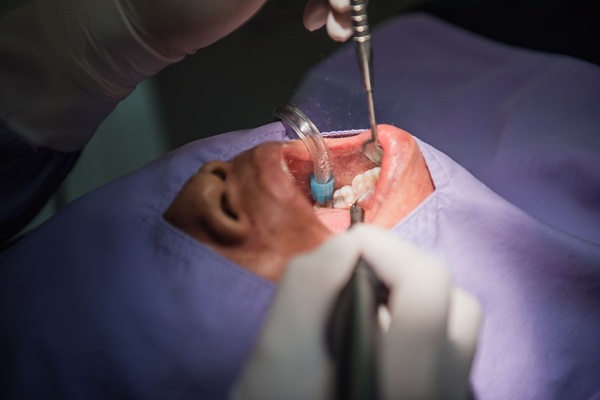 When individuals experience gum problems of any kind, it is imperative that they visit a family dentist for a thorough cleaning and possibly treatment. Gum concerns, even mild ones, are likely indicative of gum disease, the number-one cause of tooth loss in adults. Unfortunately, it often goes unnoticed in the early stages, and by the time an individual becomes concerned, the disease has already progressed. The good news is that immediate action may help to stop the spread and possibly reverse any damage.
When individuals experience gum problems of any kind, it is imperative that they visit a family dentist for a thorough cleaning and possibly treatment. Gum concerns, even mild ones, are likely indicative of gum disease, the number-one cause of tooth loss in adults. Unfortunately, it often goes unnoticed in the early stages, and by the time an individual becomes concerned, the disease has already progressed. The good news is that immediate action may help to stop the spread and possibly reverse any damage.
Gum concerns patients should not ignore
Early detection is key to managing gum disease before it progresses to a more serious form of the condition, such as gingivitis, periodontitis, or advanced periodontitis. Though painless in the early days, these are a few common signs that should spark concern:
- Tenderness, swelling, or puffiness in the gums
- Discoloration, such as red or purplish gums
- Bleeding, or a pink tinge on the toothbrush after brushing
- Receding gums
- Bad breath
- Pain when chewing
- Pus between the gums and teeth
- Loose or lost teeth
Any of these symptoms, even if they come and go, are possibly indicative of gum disease and should prompt an immediate visit to a family dentist.
Treatments for early gum concerns
If the only symptoms present include tenderness, swelling or puffiness, bleeding when brushing, and/or discoloration, a thorough dental cleaning may be all the patient needs to restore gum and oral health. Deep cleaning procedures that may help include scaling and root planing. Scaling is the process of removing any plaque and tartar buildup that lies beneath the gum line. Root planing entails smoothing the tooth root to help it reattach to the tooth. Both procedures are nonsurgical, noninvasive ways to treat the early stages of gum disease.
Lifestyle changes to prevent a reoccurrence
A family dentist is likely to recommend several lifestyle changes for the patient to stop gum disease from developing. Those may include changing the diet to promote tooth and gum health, avoiding smoking cigarettes and drinking alcoholic or sugary beverages, managing diabetes and other health conditions, and practicing good oral hygiene.
In particular, practicing good oral hygiene is one of the most effective ways one can prevent gum disease or a reoccurrence of it. A strong oral hygiene routine should entail brushing the teeth twice daily for two minutes at a time with a fluoridated toothpaste, flossing at least once a day and before brushing, and rinsing with an antibacterial mouthwash. The American Dental Association also recommends that individuals rinse their toothbrushes thoroughly after use and store them in an upright container.
In addition to practicing good oral hygiene at home, individuals should maintain regular visits with a family dentist. Ideally, visits should take place every six months, though a dentist may recommend more frequent visits if a patient has a particularly high risk for a reoccurrence of gum disease.
Conclusion
Gum problems are not issues to ignore. If any symptoms begin to arise, contact a local family dentist right away.
Request an appointment or call Carolina Smiles Family Dental at 828-884-3702 for an appointment in our Brevard office.
Recent Posts
Maintaining optimal oral health requires consistent care and professional guidance. A family dentist plays a crucial role in ensuring the dental well-being of individuals of all ages. From preventive care to addressing specific concerns, regular visits to a family dentist provide comprehensive services that help maintain healthy teeth and gums while preventing potential oral health…
Seeing your family dentist for regular checks and treatments can maintain or improve your dental health. You can avail of basic treatments during your visits. Knowing what each one is can help you make informed decisions. Here are the common treatments that you can get from your family dentist.Cavities may worsen over time. Dental decay…
A regular visit to the family dentist may reveal that a patient has a chipped or cracked tooth. A patient generally knows if a tooth is fragmented due to its appearance. A tooth can become damaged from improper biting, cavities, poor hygiene, teeth grinding, and trauma. A cracked tooth is often harder to notice because…


